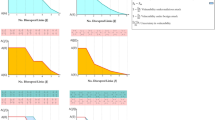Abstract
Aiming at the vulnerability propagation of all-optical networks, combining with the characteristics of the all-optical network, a formal modeling and analysis method for vulnerability propagation based on Bio-PEPA is proposed in this paper. First of all, the main characteristics that influence the vulnerability propagation are analyzed. Then, the optical fibers, optical amplifiers and optical switches are abstract into three different clusters, and the propagation behavior of vulnerability in intra-cluster and inter-cluster are described accurately. In addition, Ordinary Differential Equations is used for model parsing. Finally, through testing the main factors of vulnerability propagation, such as the number of nodes with potential vulnerability, system detection and repair rate, it is shown that the model constructed in this paper can reflect the vulnerability propagation trend of all-optical networks reasonably. At the same time, the proposed method can avoid the state space explosion problem of traditional modeling methods.
















Similar content being viewed by others
References
Deng, N., & Jia, W. (2016). Technology evolution of all optical switching. In Asia Communications and Photonics Conference (pp. 2–5).
Ebrahimzadeh, A., Rahbar, A. G., & Alizadeh, B. (2017). Online bandwidth provisioning in all optical interconnection networks of data centers: Throughput maximizing approach. Computers & Electrical Engineering, 57, 15–27.
Cheng, M. X., Crow, M., & Ye, Q. (2016). A game theory approach to vulnerability analysis: Integrating power flows with topological analysis. International Journal of Electrical Power with Energy Systems, 82, 29–36.
Silva, C., Batista, R., Queiroz, R., et al. (2016) Towards a taxonomy for security threats on the web ecosystem. In Noms IEEE/IFIP Network Operations and Management Symposium, IEEE (pp. 584–590).
Orojloo, H., & Azgomi, M. A. (2017). A method for evaluating the consequence propagation of security attacks in cyber-physical systems. Future Generation Computer Systems, 67, 57–71.
Morris-King, J., & Cam, H. (2015). Ecology-inspired cyber risk model for propagation of vulnerability exploitation in tactical edge. In Military Communications Conference, IEEE (Vol. 23(3), pp. 336–341).
Lazzez, A. (2015). All-optical networks: Security issues analysis. Journal of Optical Communications and Networking, 7(3), 136–145.
Furdek, M., & Skorin-Kapov, N. (2011). Physical-layer attacks in all-optical WDM networks. In 2011 Proceedings of the 34th International Convention MIPRO, IEEE (pp. 446–451).
Furdek, M., & Skorin-Kapov, N. (2012). Physical-layer attacks in transparent optical networks. In N. Das (Ed.), Optical Communications Systems. Available from: http://www.intechopen.com/books/optical-communications-systems/physical-layer-attacksin-transparentoptical-networks.
Ma, J., Zhang, L., Zhang, S., et al. (2013). Vulnerability analysis of the optical network NMS. In Second International Conference on Instrumentation, IEEE.
Patel, D. S., & Pancholi, P. N. (2013) Security issues and attack management in AON—A review. In International Conference on Emerging Technology Trends in Electronics, IEEE.
Habib, M. F., Tornatore, M., Dikbiyik, F., et al. (2013). Disaster survivability in optical communication networks. Computer Communications, 36(6), 630–644.
Wang, J., Zhang, Y., et al. (2012). Research on assessing the vulnerability of optical network from the network geography distribution. In Fourth International Symposium on Information Science and Engineering, Shanghai (pp. 7–11).
Ruiz, M., & Velasco, L. (2014). Vulnerability modelling for periodical flexgrid network planning. In International Conference on Transparent Optical Networks, IEEE.
Meixner, C. C., Dikbiyik, F., Tornatore, M., et al. (2013). Disaster-resilient virtual-network mapping and adaptation in optical networks. In 2013 17th International Conference on Optical Networking Design and Modeling, IEEE.
Omer, M., Nilchiani, R., & Mostashari, A. (2009). Measuring the resilience of the trans-oceanic telecommunication cable system. IEEE Systems Journal, 3(3), 295–303.
Agarwal, P. K., Efrat, A., Ganjugunte, S., et al. (2013). The resilience of WDM networks to probabilistic geographical failures. IEEE/ACM Transactions on Networking, 21(5), 1525–1538.
Jirattigalachote, A., Skorinkapov, N., Furdek, M., et al. (2011). Sparse power equalization placement for limiting jamming attack propagation in transparent optical networks. Optical Switching and Networking, 8(4), 249–258.
Ebrahimzadeh, A., Ghaffarpour Rahbar, A., & Alizadeh, B. (2016). Cost efficient amplifier placement and gain adjustment in all-optical networks: A noise-minimizing approach. Optik-International Journal for Light and Electron Optics, 127(23), 11191–11210.
Manousakis, K., & Ellinas, G. (2016). Attack-aware planning of transparent optical networks. Optical Switching and Networking, 19(2), 97–109.
Zhao, H., Mamoori, S. A., Jaekel, A. (2016). Attack-aware RWA using knowledge of demand holding times. In Electrical and Computer Engineering, IEEE.
Xiao, Y., Shao, A., Dou, Q., et al. (2013). Dedicated-path protection algorithm for preventing high-powered optical crosstalk in Transparent Optical Networks. In Wireless and Optical Communication Conference (pp. 523–526).
Skorin-Kapov, N., Furdek, M., Pardo, R. A., et al. (2012). Wavelength assignment for reducing in-band crosstalk attack propagation in optical networks: ILP formulations and heuristic algorithms. European Journal of Operational Research, 222(3), 418–429.
Sun, Z., Peng, Y., & Long, K. (2011). Propagation effect of high-powered jamming attack in transparent optical networks. Proceedings of SPIE—The International Society for Optical Engineering, 8310(1), 1–6.
Ciocchetta, F., & Hillston, J. (2009). Bio-PEPA: A framework for the modelling and analysis of biological systems. Theoretical Computer Science, 410(33), 3065–3084.
Ciocchetta, F., Duguid, A., Gilmore, S., et al. (2009). The Bio-PEPA tool suite. In The 2009 Sixth International Conference on the Quantitative Evaluation of Systems (pp. 309–310).
Agrawal, A., & Khan, R. A. (2012). Role of coupling in vulnerability propagation. Software Engineering, 2(1), 60–68.
Acknowledgements
This work is supported by the National Natural Science Foundation of China (61403109), the Specialized Research Fund for the Doctoral Program of Higher Education of China (20112303120007) and the Scientific Research Fund of Heilongjiang Provincial Education Department (12541169).
Author information
Authors and Affiliations
Corresponding author
Additional information
Publisher's Note
Springer Nature remains neutral with regard to jurisdictional claims in published maps and institutional affiliations.
Rights and permissions
About this article
Cite this article
Zhao, ZN., Wang, J. & Guo, HW. Analysis of vulnerability propagation for the all-optical network based on Bio-PEPA. Wireless Netw 25, 3513–3529 (2019). https://doi.org/10.1007/s11276-019-01947-2
Published:
Issue Date:
DOI: https://doi.org/10.1007/s11276-019-01947-2




